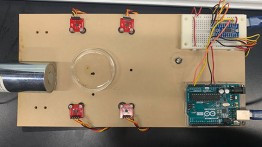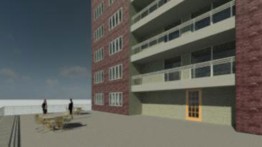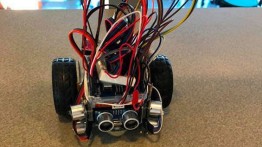Senior Snapshots: Engineering 2019
POSTED ON: May 17, 2019
In this third and final installment of our annual series, we meet Skylar Eiskowitz, Gabriela Godlewski, Sara Huang, Zhekai Jin, and Iram Rahman, graduating seniors from each of the five majors at the Albert Nerken School of Engineering. They spoke to us about their time at Cooper, their senior projects, and what they have planned after graduation.
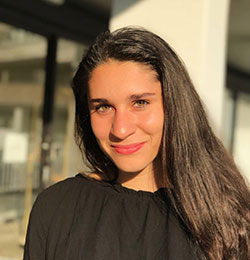 Skylar Eiskowitz, a mechanical engineering senior, is a devout reader of SpaceNews. “Every day there’s always something different happening,” she says, rattling off a list of recent aerospace industry headlines: “The first picture of a black hole, the Israeli lunar lander crashed, Mike Pence announced we’d go back to the moon by 2024…” These are the sort of topics offered up for discussion at meetings of The Cooper Union chapter of Students for the Exploration and Development of Space (SEDS), of which Skylar is both the president and founder. “The main idea behind the club was to be part of the space community, since Cooper and New York City didn’t have much.”
Skylar Eiskowitz, a mechanical engineering senior, is a devout reader of SpaceNews. “Every day there’s always something different happening,” she says, rattling off a list of recent aerospace industry headlines: “The first picture of a black hole, the Israeli lunar lander crashed, Mike Pence announced we’d go back to the moon by 2024…” These are the sort of topics offered up for discussion at meetings of The Cooper Union chapter of Students for the Exploration and Development of Space (SEDS), of which Skylar is both the president and founder. “The main idea behind the club was to be part of the space community, since Cooper and New York City didn’t have much.”
In fact, attending The Cooper Union seems in hindsight an unlikely path for Skylar, an avid surfer from Long Island who in high school gravitated more towards math and physics than the hands-on world of engineering. “I was so lost when applying to college. I loved math in high school, and what scared me about Cooper was that you really can’t do anything other than engineering,” she says. “I don’t know why I would ever choose Cooper. I loved the idea of having a campus when I was visiting other schools. I’m not a city person at all—I love the beach.” Still, at the urging of her parents, she did some investigation and found herself drawn to the strong reputation and small size of the school.
“The special thing about Cooper is that, because we’re not a research institution, it’s very easy to get close to faculty members, and they’re very welcoming,” she says. “Professor Alan Wolf has been a huge mentor of mine.” After starting out as a civil engineering student, she found that mentorship decisive for making the switch to mechanical engineering early on. “I went through this phase where I really wanted to do physics and was wondering if I should transfer,” she says. “Mechanical was a better option for me, since it's broad. It’s allowed me to get the physics and math stuff in my coursework.”
It was in the summer after her sophomore year that she discovered the relevance of aerospace to her interests. Through the University of Maryland’s TREND program, part of the NSF’s Research Experience for Undergraduates, she landed an internship opportunity looking at orbital dynamics in Saturn’s rings. Her research mentor encouraged her to pursue aerospace further, and in the following year she became one of 41 students nationwide to win the Brooke Owens Fellowship, which provides paid internships for exceptional undergraduate women in aerospace. Her internship took her to Avascent, an aerospace consulting firm in Washington, D.C. “I had no idea what aerospace was,” she recalls. “But being surrounded by people with such impressive resumes motivated me to learn more about it.”
When she returned to school that fall, at the outset of her senior year, she organized the first meeting of SEDS. “I wanted us to become a chapter because it’s very student-oriented, whereas other organizations seemed more career focused.” On top of her involvement with the club, Skylar has spent the latter part of her senior year working on a capstone research design project with a team supervised by Professor Philip Yecko and Professor Dirk Martin Luchtenberg. The team is investigating an area of research called magnetic direct targeting, in which scientists administer a cancer treatment and control the drug with external magnets to move it directly to the tumor. “The problem we found in other research in this area is that many lab setups are too idealized,” she explains. “We’re trying to create a more realistic setting in which to test. Instead of using cameras, we’re optimizing the setup using sensors that detect the movement of the magnetic drug. There’s a localization algorithm that then tells you exactly where the drug is.”
Though the project has helped her gain some useful skills, she doesn’t see herself working with hardware in the future. “The further away from the machine shop I am, the better,” she says. “I like computational work.” Through her internships, she’s come to realize aerospace is the side of mechanical engineering that she ultimately wants to continue focusing on: “Before coming to Cooper, the idea of graduate school was never in my mind. Professor Wolf woke me up to that. I love physics, so he recommended that I go to graduate school, and now I’m realizing that was for sure the right move.”
In the fall, Skylar will be heading to MIT’s AeroAstro graduate program on an NSF Graduate Research Fellowship, which will fund her research. “I’ve always had this struggle over whether I want to do more technical work or focus on making a big impact,” she says. “I want both, and I think my next step does a good job of that.” Choosing the right program wasn’t easy though, and she passed on offers that may have been more geographically conducive to her extracurricular interests: “I was determined to surf in grad school, but I ended up choosing MIT based on the advisor and research projects. My advisor’s work ranges from connecting more people to the internet to planning NASA missions. I really liked having different research options.”
In the meantime, she’ll be spending the summer interning at The Aerospace Corporation in Los Angeles, where she’ll be working in the modeling and simulations department. “The Aerospace Corporation really enticed me because they say they only hire people with advanced degrees,” she says. “I think being around that will help me see if I want a PhD.” Best of all, the office is 15 minutes from the beach. “I really wanted to get the California experience somehow.”
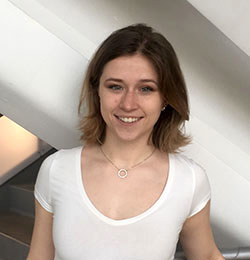 From her home borough of Staten Island, Gabriela Godlewski witnessed the impact of climate change firsthand when Hurricane Sandy hit in 2012. “Seeing what was going on in my neighborhood was unbelievably important to me,” she says. That experience became a deciding factor in pursuing civil engineering at Cooper. “I figured it was the best way for me to work through Sandy. Civil engineering would allow me to build infrastructure that’s resistant to hurricanes.”
From her home borough of Staten Island, Gabriela Godlewski witnessed the impact of climate change firsthand when Hurricane Sandy hit in 2012. “Seeing what was going on in my neighborhood was unbelievably important to me,” she says. That experience became a deciding factor in pursuing civil engineering at Cooper. “I figured it was the best way for me to work through Sandy. Civil engineering would allow me to build infrastructure that’s resistant to hurricanes.”
The Cooper Union has been on Gabi’s radar for a long time. “I always felt Cooper was my dream school,” she says. Her relationship with the school began as far back as eighth grade, when she first applied to the Saturday Program. “I was rejected. I applied every single year through high school, and then got in during my senior year off the waitlist. I hadn’t applied for architecture, but I was still happy to be in that class and spend every Saturday for a year being trained by the fifth-year architecture students.”
The wait was worth it, according to Gabi. “Even though the school has been really hard, I can’t see myself anywhere else.” She recalls the day she got accepted to study civil engineering: “I was emotionally drained from the college application process. My SatPro instructor gave me the biggest hug. I was so happy knowing I would remain here for the next four years.” Enrolling as a civil engineering student, she wasn’t sure what to expect, other than that the curriculum was going to be difficult. Her enthusiasm for addressing environmental issues, however, gave her a strong sense of direction.
“Almost every single one of my projects in some way, shape, or form has taken on the problem of climate change, how it’s affecting coastal cities, and what can be done,” she says. That passion for connecting academic work to real world engineering problems resulted in a trip to Houston during the summer prior to her senior year to study the city’s post-hurricane efforts, a research project for which she received the Benjamin Menschel Fellowship. “I wanted to see if I could take advantage of the Menschel Fellowship to do more work related to flooding,” she says. “My advisor suggested choosing one place and comparing it with what I knew from Sandy. I decided to go to Texas because they were still recovering from Harvey. It was interesting to see the differences—very affluent neighborhoods there were already almost completely reconstructed, while there are still houses in NYC that haven’t even started.”
Gabi has continued some of her work on flood resilience as part of her civil engineering senior project, which splits students into groups and asks them to choose a plot of land that’s accessible from Cooper on which to propose a building project with a $100M budget. Her group decided to look at an actual building being proposed: Developers want to construct a 100-story glass tower in the flood-prone Two Bridges neighborhood of Manhattan, an area predominantly occupied by low-rise buildings and low-income housing. “My group members, April Mintz CE’19 and Kirsten Ondris CE’19, wanted to propose a better building that would benefit the community,” she says. “We came up with ground rules. We wanted it to be modern and comfortable, but it couldn’t stand out from or exceed the height of surrounding buildings. It couldn’t block off views of the river, and we wanted to prioritize implementation of low-income housing. It’s right along the water, so we also had to put in retractable flood gates.”
Gabi’s next step after graduation will bring her to the Netherlands, perhaps the ultimate destination for studying flood control, to attend graduate school for hydraulic engineering at Delft University of Technology. “There’s a saying that goes, ‘God created the world, the Dutch created the Netherlands,’” she says. “It’s so vulnerable to flooding, so it has the best engineers. I’m looking forward to studying there and continuing research on climate change research.”
Her advice for other undergraduates is not to shy away from getting involved. Being active in the Engineering Student Council and the Joint Student Council, she says, has significantly shaped her experience at Cooper. “It’s validated my time here. I felt like I was contributing directly to the community.” She also warns against worrying too much: “I think we all at some point experience imposter syndrome. I wish I could tell new students not to worry about why you’re here or whether you belong. Just take advantage of the fact that you are here.”
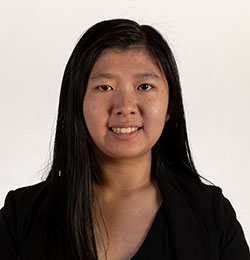 Sara Huang thrives under pressure. “I like the challenge,” she says. “Whenever I have a deadline or a problem to solve, it’s amazing to see how much you can do in a short amount of time when you’re in stress mode.” That mentality has gotten her through some tight spots, such as recently finishing what was supposed to be a semester-long group software project in just a few short weeks and, in the end, coming out ahead. “We were in a pinch. We were using the Apollo framework in Java, but we weren’t proficient in it. So, we switched our framework and suddenly everything became crystal clear. I like getting to see how much I can achieve when push comes to shove.”
Sara Huang thrives under pressure. “I like the challenge,” she says. “Whenever I have a deadline or a problem to solve, it’s amazing to see how much you can do in a short amount of time when you’re in stress mode.” That mentality has gotten her through some tight spots, such as recently finishing what was supposed to be a semester-long group software project in just a few short weeks and, in the end, coming out ahead. “We were in a pinch. We were using the Apollo framework in Java, but we weren’t proficient in it. So, we switched our framework and suddenly everything became crystal clear. I like getting to see how much I can achieve when push comes to shove.”
She’s taken a similarly unflappable troubleshooting approach to her college experience. Born and raised in Queens, she came to Cooper as a chemical engineering major before deciding to pursue a Bachelor of Science in Engineering. She noticed halfway through her sophomore year that she was prioritizing math coursework over core classes. “I think you start to see you do the work for the classes you really like first.” Math became a prevailing interest in her academic work, leading her to favor electrical engineering and software courses. “I took classes that I think I wouldn’t otherwise have taken,” she says. “In major-specific tracks you have designated courses, but in general engineering you can pick and choose. Some really great advice I got from older students was to just take classes that interested me, even if I don’t know how I’m going to do.”
Sara’s affinity for electrical engineering has culminated with her group-based senior project, in which she worked with EE students to design, build, and program a robotic “mouse” capable of autonomously navigating a maze for the IEEE Region 1 Annual Student Conference Micromouse competition. The path to the competition was not without obstacles, however. “It had its ups and downs,” says Sara, whose focus was primarily the logistics of the project. “We got it working, something blew a fuse, so we had to get that fixed.” Then, during tests the night before the competition, she faced another setback. “I was holding our micromouse, and as I went to pass it to someone, I fell. It was really embarrassing. The deans had to help me up. I told my team to just keep going—get the mouse to the competition.”
The team’s perseverance paid off when, out of 17 entries, their micromouse made it third closest to the end of the maze. Although they didn’t take third place overall (speed is also a factor), Sara’s team won the $100 judge’s prize for most unique design. “They liked that we had a right-turn mechanism,” she explains. “We also had a nice auto-correcting mechanism, which allowed the micromouse to correct its path in a straight line. I think that set us apart from other teams.”
Sara is in fact a veteran of engineering competitions. In the summer before her junior year, she and Keti Vaso ChE’19 won first place in the 2017 Invention Factory for their project Hid-In, an improved insulin injector pen. Following that success, they decided to enter the invention in SASETank, an entrepreneurial competition organized by the Society of Asian Scientists and Engineers (SASE). It turned out to be a more significant decision than Sara realized at the time. “We applied to the SASETank competition, but we found out you have to be a member and attend the SASE conference,” she explains. “So, I went and have been involved with SASE ever since. I went to their spirit week, I go to their events. I really wish I joined earlier.” As for SASETank, Sara and her partner ended up winning the $750 second-place prize.
Looking back at her time at Cooper, Sara says she has appreciated having such a close-knit community. “I think that’s what makes Cooper unique. You get to be involved in a lot more things, you can wear many different hats.” Being a general engineering student, having that flexibility and closeness has shaped her academic experience, and she says that an important part of transitioning from high school to college has been adjusting to the personalized attention from faculty. “Here, the classrooms are really small. I like that because I guess I’m a needy person and I like all the attention,” she jokes. “I didn’t expect professors to notice when I’m absent. At some point in my freshman year when I was really sick, I was absent from class and my professor emailed, saying ‘Hey, I just want to make sure you’re OK.’ I really value that.”
As she prepares for graduation, Sara is unsure what the future holds. She was recently accepted to Stevens Institute of Technology for a graduate program in data science, but she’s not yet sure whether she’ll decide to go straight into the workforce, as she’s also been applying for software-related jobs at various startups and tech companies. Whatever her next step, she’s confident her time at Cooper has prepared her well. “Cooper means everything to me,” she says. “I feel indebted to Cooper because it’s given me so much over these past four years. I’m going to miss it a lot.” Asked what stands out the most about her time here, she says it’s been the rigor. “Whenever I think about Cooper, I think about how hard it is. But I feel like after going through that, you can do anything.”
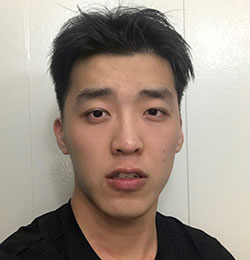 Zhekai (Scott) Jin, who graduates this month with a bachelor’s in electrical engineering, sees application as the key to learning. “Engineering is very connected to life,” he says. “It gets you to knowledge about the world.” As a student at a foreign language high school in Hangzhou, the city in China where he grew up, Scott’s fascination with applying math and science to technical problems led him to get involved with robotics, though at the time he wasn’t sure what he wanted to study in college. “I was intimidated by higher level mathematics and advanced physics,” he says. “I was more inclined to the application side of engineering.”
Zhekai (Scott) Jin, who graduates this month with a bachelor’s in electrical engineering, sees application as the key to learning. “Engineering is very connected to life,” he says. “It gets you to knowledge about the world.” As a student at a foreign language high school in Hangzhou, the city in China where he grew up, Scott’s fascination with applying math and science to technical problems led him to get involved with robotics, though at the time he wasn’t sure what he wanted to study in college. “I was intimidated by higher level mathematics and advanced physics,” he says. “I was more inclined to the application side of engineering.”
He applied to The Cooper Union on the recommendation of a counselor, and after getting accepted, decided to move to New York sight unseen. “Cooper was actually my first offer, so I researched its engineering program, but didn’t have time to visit.” Name recognition is important in China, he says, and it took some time to convince his family that a smaller school like The Cooper Union was the right choice. In the end, he says he was drawn to the prospect of working closely with faculty, something that has turned out to be formative to his time here.
His interests in programming and solving computation problems crystalized during freshman year while working on The Cooper Union Motorsports’ Formula SAE team, in which students build, test, and race a formula-style car. “The formula car was interesting, but it was too focused on the electrical side for me,” he says. “I was drawn to computer engineering and working on the algorithm part.” Through an internship between his junior and senior years, Scott found himself circling back to robotics. While interning for Momenta.ai, an autonomous driving company, he learned from a coworker about a problem in robotics known as simultaneous localization and mapping, or SLAM. “I got interested and wanted to continue with this research problem,” says Scott, who in the following semester recruited two mechanical engineering students and formulated what would become their senior project.
“Imagine you are a robot and you are dropped somewhere you’ve never been before. You try to learn where you are, which is localization, and also try to map your environment,” Scott explains. The group’s autonomous driving research platform focuses on SLAM with the goal of improving the ability of robots to navigate unknown environments autonomously. As part of the project, they developed The Cooper Mapper, a robotic car equipped with cameras and LiDAR (a type of laser scanning technology) to create high definition 2D and 3D mappings of its surroundings. Scott’s teammates were tasked with securing the sensors and building the car, while he focused on creating the algorithm that makes it all work.
“It’s a difficult engineering problem,” he explains. “When you try to localize yourself you need a map, and when you try to make a map you first need to know where you are. It’s mathematically solvable, but there are still many existing engineering challenges for application, so we’re trying to optimize it and make an approachable research platform for future study.” In addition to taking the first-place prize at the IEEE Region 1 Student Paper Competition this past March, The Cooper Mapper research platform was awarded funding through the internal Cooper Union grant program in April.
The team also just recently ran a workshop for training other students to continue the research project as part of the SMAC2 Lab, which Scott has been involved with from early on. “During my second year I talked to Professor Neveen Shlayan about my research goals and helped her set up the lab and equipment,” he says. “It’s one of the reasons I think Cooper is different than other schools. Cooper is small, and I really got to know my professors very well.”
This month, Scott is moving to Pittsburgh to begin research at Carnegie Melon University, where he will be pursuing a master’s degree in robotics. “I’m doing research in the summer to see what it’s like being in a big research institution,” he says. “New York is kind of fast for me, so I think Pittsburgh will enhance my study. Less distraction.” He explains that research in the field of robotics can be divided into three areas: control, planning, and perception. “Control is more mechanical, while perception and planning are more on the algorithm side. Right now, I’m interested in the perception side, but I will take courses in the other two areas.” He hopes to gain academic experience, but he isn’t sure yet whether he wants to eventually continue to a PhD. “My goal is to go into industry after my master’s,” he says. “Then I’ll see where I am. There is still a long way to go.”
 Engineering may have been the natural choice, given his penchant for tinkering and taking things apart, but it was environmentalism that drew Iram Rahman to chemical engineering specifically. While other high school students would head home after class, Iram could be found in the woods behind the school experimenting with alternative fuel sources for his science research lab. “There was something about the large-scale processes involved with chemical engineering that was really attractive to me,” he says. “I knew it was something I wanted to do. I knew that if I’m going to do all this work while people are going home or having fun, that I would want to keep working with the environment and alternative energy in college.”
Engineering may have been the natural choice, given his penchant for tinkering and taking things apart, but it was environmentalism that drew Iram Rahman to chemical engineering specifically. While other high school students would head home after class, Iram could be found in the woods behind the school experimenting with alternative fuel sources for his science research lab. “There was something about the large-scale processes involved with chemical engineering that was really attractive to me,” he says. “I knew it was something I wanted to do. I knew that if I’m going to do all this work while people are going home or having fun, that I would want to keep working with the environment and alternative energy in college.”
Iram, who has lived in the New York City area his entire life, found out about The Cooper Union through a cousin who had attended. "The first thing I heard about Cooper was that it was too much work,” he recalls. Going to a large high school on Long Island, however, made the idea of coming to a small urban college attractive, not only because of the academic challenges but also for the opportunity to strike out on his own. “I really liked the idea of having this little nest of high-intensity learning, and the idea of having a closed college campus was always odd to me. Coming here I knew that I would become an adult." In spite of his cousin’s warnings, he says the transition to Cooper was positive. “It was a humbling experience, to have to put in that work and compete with people who are wildly intelligent.”
One of the first hands-on engineering projects that he got involved with in his freshman coursework was the Formula SAE team. "It introduced me to the type of work that I’d be able to do here,” he says. “It was really beneficial to have that experience early on, while you’re going through rigorous academics—chemistry, calculus, writing classes—and having that project course put things into a greater context.”
Working on the formula team, which Iram has done throughout his time at Cooper, has also presented the opportunity to tie in his passion for sustainability. “I wanted to push beyond just understanding how the engine works,” he says. “The goal when we tune that engine is power, but something we never consider, and something the Formula SAE competition doesn’t really look at, is the emissions of these cars. It’s not regulated, so it was something that I started pushing for us to look at.”
Iram credits much of his success at Cooper to the influence of two faculty mentors in particular, Professor Amanda Simson and Professor Jennifer Weiser, both of whom joined the chemical engineering faculty in 2017. “Those two professors have changed my time here,” he says. “I’m involved with so many projects now because of them.” One of those projects has recently involved working with Professor Weiser and a master’s student to map airflow in hospital rooms at Montefiore Medical Center in the Bronx. “We are trying to demonstrate to doctors that different ways a room is run can change airflow. It has to be a very sterile environment, and a lot of times the vents are blocked, people are coming in and out, and it’s hard to visualize how that can affect airflow, which in turn can affect patients and infections rates.”
This past year, Iram has also been able to pursue research that directly aligns with his environmental interests. As part of the group-based senior “capstone” project, which asks students to design and plan the operation of a chemical plant, he and his team worked to develop a biologically sourced alternative to jet fuel production. “I was really excited when I found out it was environmentally focused energy generation,” he says. “We had to figure out how we can operate this plant in a way that won’t compete with freshwater or agriculture, how we can process fuel that people can use as an alternative to carbon-emitting processes, and how we can maintain this in a way that follows EPA regulations.” In trying to remain as true to life as possible, the group’s research has been extremely detailed, he says. “We asked how much we need to pay workers, what health insurance do they need, how do safety mechanisms work, how do we buy things and who do we buy them from?”
In June, he starts working for Watts Water Technologies, joining his friend Daniel Galperin ChE’18, who we profiled in a Senior Snapshot last year. Iram explains that his role will focus on applying new technologies to make boiler systems more efficient and environmentally friendly. He is looking forward to applying his skills to industry, he says, with the ultimate goal of working to integrate systems with environmental policies in a way that is economically feasible and sustainable for the future. “It’s something I’ve worked on throughout my time here at Cooper, and now it’s something I will actually be able to work on as I proceed with my career.”

